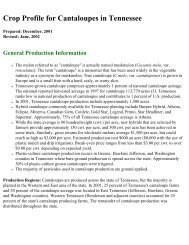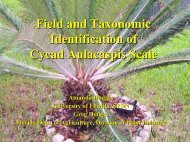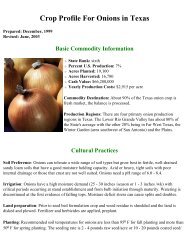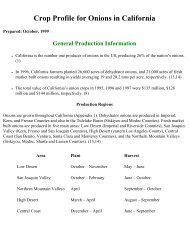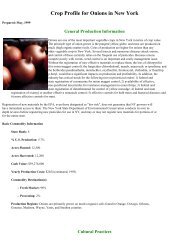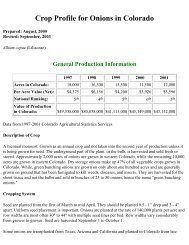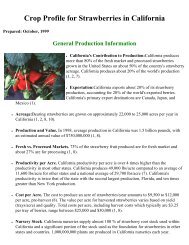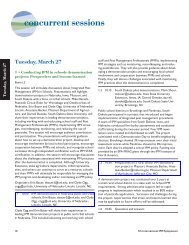Crop Profile for Cherries (Sweet) - Regional IPM Centers
Crop Profile for Cherries (Sweet) - Regional IPM Centers
Crop Profile for Cherries (Sweet) - Regional IPM Centers
You also want an ePaper? Increase the reach of your titles
YUMPU automatically turns print PDFs into web optimized ePapers that Google loves.
Glyphosate (Roundup, Touchdown, Glyphomax, others) - Glyphosate is usually applied at rates from<br />
0.75 to 3.0 lbs. a.e./acre (0.3 to 1.2 lbs. a.e./orchard acre). Proper use of this product has eliminated most<br />
perennial weeds as a problem in most orchards. Glyphosate has been especially useful in control of<br />
perennial grasses and field bindweed, allowing growers to reduce the rates of residual herbicides. Some<br />
growers apply this product at very low rates in mid-summer to control weeds that have escaped earlier<br />
control ef<strong>for</strong>ts so that weeds remain small during the critical mid-summer harvest time. This product can<br />
not be safely applied to the trunks of younger, smaller orchard trees.<br />
Paraquat (Gramoxone) - Paraquat is applied at 0.31 to 0.94 lbs. a.i./acre (0.125 to 0.38 lbs. a.i./orchard<br />
acre). This product is commonly used as a "chemical hoe" in younger orchards because lower rates and<br />
dilute solutions can be applied to the tree trunks safely. As it controls only small, emerged annual weeds,<br />
it must be applied to newly emerged weeds no more than 4-6 inches in height. Unless it is tank mixed<br />
with a residual herbicide, it must be applied as many as three to four times per growing season to<br />
maintain weed control in the young orchard. Because of the expense and because paraquat will not<br />
adequately control perennial weeds, it is rarely used in mature orchards.<br />
2,4-D (amine <strong>for</strong>mulations) - 2,4-D is used at a rate of 1.4 lbs. acid equivalent/acre (0.56 lbs. acid<br />
equivalent/orchard acre). As this product will not kill target weeds when applied at this rate at the proper<br />
timing, its use is declining. It is most used at the lower rate range in combination with other products,<br />
such as glyphosate, to enhance control.<br />
Cultural Control<br />
Mechanical weed control is used as an alternative to chemical control only in organic orchards or those<br />
converting to organic. Mechanical control disturbs soil, increasing the threat of soil erosion, and<br />
increasing the rate of organic matter breakdown. In addition, because orchard sprinkler systems must be<br />
designed to hang above the soil surface to allow mechanical weed control, most growers find it difficult<br />
to implement this method in a conventional orchard. Other weed control alternatives include plastic<br />
mulches. These have not worked well past the second season of use because they are very expensive and<br />
pose a waste disposal problem after they deteriorate. Some growers are experimenting with flaming,<br />
steam, or hot water sprays, which have not worked well yet. These methods may damage the trees,<br />
pollute the air, and lead to high use of fossil fuels. Flaming, <strong>for</strong> instance, requires about 20 gallons of<br />
propane per acre per application and as many as four applications per season.<br />
Biological Control<br />
Biological weed control plays almost no role in orchards.<br />
Rodents



